A couple of weeks ago, as I travelled by train to Northampton Station, I was repeatedly struck by the prominence of churches in the landscape of Buckinghamshire and Northamptonshire. Spires, and also towers, were visible in the distance and the foreground, punctuating every hill or valley the train past. Most prominent are the beautiful spire of Hanslope Church, or the wonderful gothic tower meets baroque cupola of Northampton’s All Saints in the heart of the town centre. I was thinking about how churches, regardless of religious function stand prominently as landmarks for every village or town. Visible, from a great distance, steeples have been used for defence, for map making, for one-upmanship. Ancient and infinite. The most prominent elements of the English landscape. And then I went to Cumbria.
The Lake District is about as extreme as the English landscape ever gets. Mountains, moors, forests, waterfalls, oh, and lakes. I was staying in beautiful Borrowdale, surrounded by the highest mountains in England. Hemmed in by impressive stone cliffs. The little hamlets are not visually dominated by their churches, but by their landscape. The simple churches I visited were little more than barns with Victorian gothic windows and bell-cotes. These buildings feel raw and untamed. They are not works of art, but of function. Interiors of Cumbrian churches sadly lack the ruggedness of their exteriors. They may be more integral to the daily life of the village, but they do not mark the village out, as the churches do of lowland Britain. The difficulty of transporting materials, the relative lack of communication, and the lack of wealth have left churches which do not have the visual prowess of Somerset Towers or floating clerestories of East Anglian wool churches.
Here, the mountains are prominent, the churches are hidden. No hilltop in Northamptonshire is complete without a view of at least four or five churches. Likewise, no Cumbrian church is complete without a view of four or five fells.


No comments:
Post a Comment